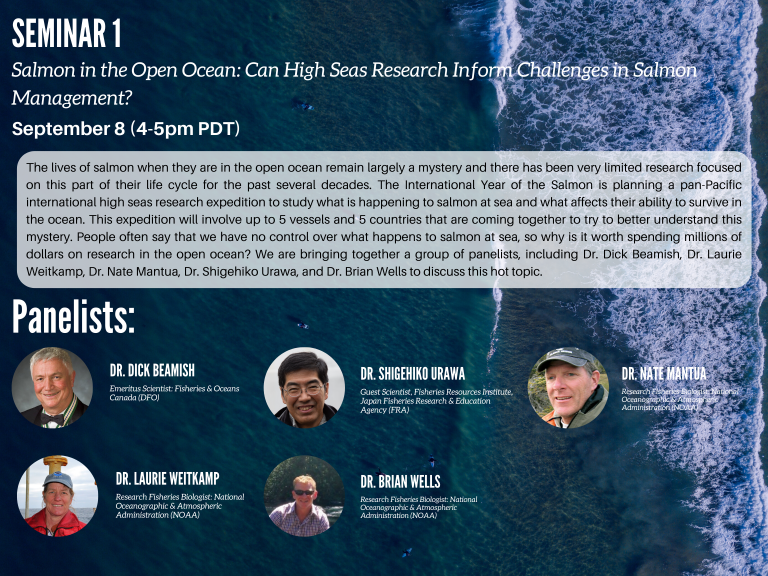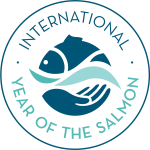Salmon in the Open Ocean: Can High Seas Research Inform Challenges in Salmon Management?
Camille Jasinski, IYS Communications Coordinator
Caroline Graham, IYS High Seas Expedition Coordinator
October 1, 2021
In September 2021, the International Year of the Salmon (IYS) kicked off its first virtual seminar series: Exploring Frontiers of Salmon Research in Open Ocean Ecosystems. This 7-part series will explore a diverse range of topics leading up to the 2022 IYS Pan-Pacific Winter High Seas Expedition, an international, multi-vessel research expedition surveying the winter ecology of salmon across the North Pacific Ocean. People often say that we have no control over what happens to salmon at sea, so why is it worth spending millions of dollars on research in the open ocean? On September 9th, 2021 the IYS brought together a group of panelists, including Dr. Dick Beamish, Dr. Laurie Weitkamp, Dr. Nate Mantua, Dr. Shigehiko Urawa, and Dr. Brian Wells to discuss this hot topic as part of the first seminar in the IYS Seminar Series. Below we summarize the major discussion points from this seminar.
The vast North Pacific Ocean is an area that remains quite mysterious to scientists studying the complex lives of salmon. Pacific salmon begin their lives in freshwater, migrate into the open ocean where they feed and grow and spend the majority of their adult lives, and return to the same freshwater streams in which they were born to spawn and die. Over the last few decades, resources to study salmon in the Western Pacific have been largely invested in freshwater research, and limited studies have examined climate change and salmon in the high seas. In the face of rapidly changing ocean ecosystems, there is a growing need to understand how salmon will survive the critical marine phase of their life cycle.
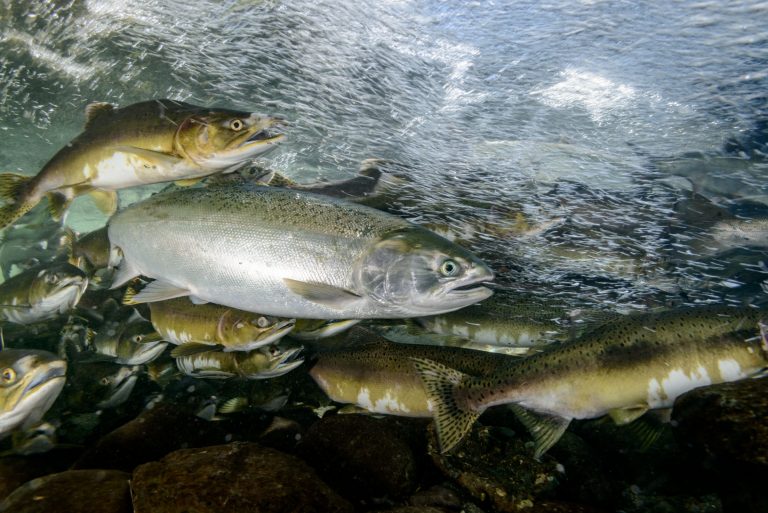
Due to rapid climate change, physical and chemical states of the ocean (like pH, heat content, and temperature) are reaching levels beyond historical records, which threatens salmon habitat in the high seas and causes changes in the food available to salmon. Twenty years ago, for instance, nobody could have predicted the back-to-back series of intense marine heatwaves in the North Pacific, which started around 2014 and are still ongoing today. Although salmon are resilient species which have survived and colonized for millennia, it is important to understand how they will adapt to increasing changes in climate and the ocean’s capacity to sustain them.
To date, significant resources have been invested in attempting to understand and manage the freshwater phase of the salmon life cycle to try and maximize salmon productivity. This is largely because it is easier to study salmon in rivers and streams compared to the open ocean, and there are more management levers available to control in freshwater. Management levers could include, for example, habitat restoration to give salmon a better chance to thrive in streams and rivers, or releasing more hatchery-reared salmon into freshwater in hopes that more salmon will eventually return from the ocean.
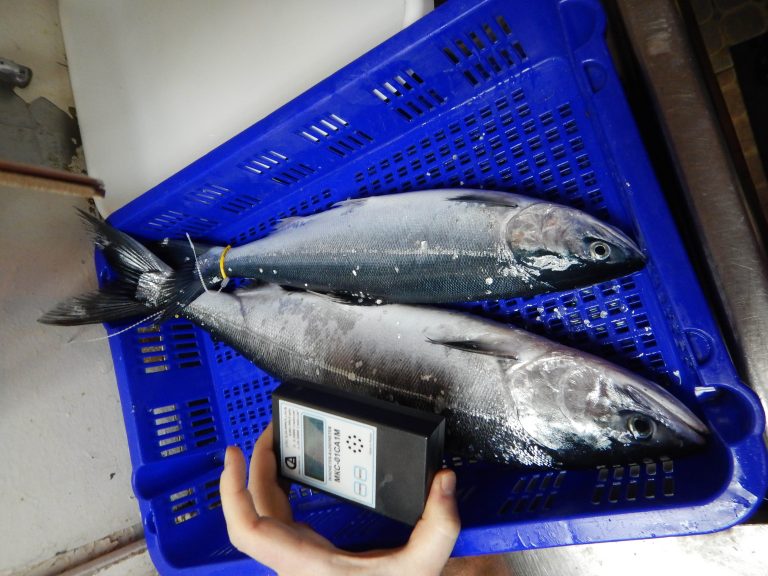
While understanding the freshwater phase is critical to managing and understanding salmon productivity, we also need to understand how freshwater conditions lead to “carryover effects” that could increase or decrease a salmon’s chances to survive the ocean period of their life cycle. The size of fish has been shown to affect their ability to survive in the ocean, which means it is an effect that is carried over from freshwater into the ocean phase of their lives. To fully understand these carryover effects and how to control them when they are controllable, we have to understand the conditions salmon face at sea. For example, the size of juvenile salmon when they enter the ocean is dependent on a lot of different factors in freshwater, including natural factors such as food availability and river and stream temperature, or human-related factors, such as hatchery release times. Further research into the critical marine phase of the salmon life cycle can help inform and redirect our salmon management practices. By using data obtained on the high seas to modify freshwater management levers, managers and decision makers may help to predict and even increase the resiliency of salmon during their high seas phase.
One of the most significant management issues that could be addressed by high seas salmon research is being able to better predict salmon returns by studying the connection between returns and key indicators, such as ocean temperature or the abundance of nutritious salmon prey in the high seas. Research similar to studies conducted on the 2019 & 2020 International Gulf of Alaska Expeditions, as well as the upcoming 2022 Pan-Pacific Expedition, allows us to build processes to monitor indicators to find the physical and biological drivers of salmon growth and survival. Improving our understanding of the mechanisms regulating salmon abundance also means linking our coastal understanding of these mechanisms to the open ocean. As we enter an era of ecological surprise driven by a changing climate, being able to predict how many salmon will return will significantly improve our ability to manage and sustain salmon into the future.
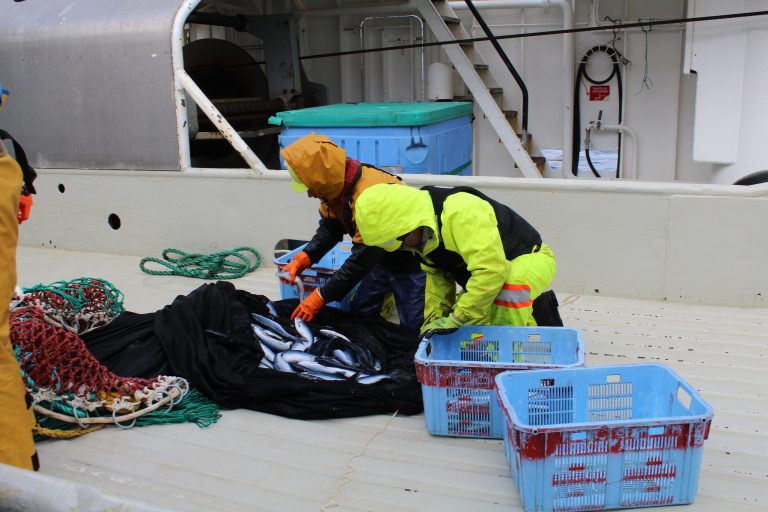
The complex and intricate lives of salmon, coupled with unpredictable and rapidly changing marine ecosystems, challenges our ability to make forecasts even in the near future. Recent decades have seen a steady decline in salmon stocks across many parts of the North Pacific, so what can we expect to learn in 2022? Ultimately, the goal of high seas research like the IYS Expeditions is to better understand and manage salmon productivity, and this is an opportune time to challenge current paradigms. Salmon and the scientists who research them are in a biologically, physically, and chemically new world. The best available science suggests that these changes will continue for many years to come and we need to learn how to deal with them.
